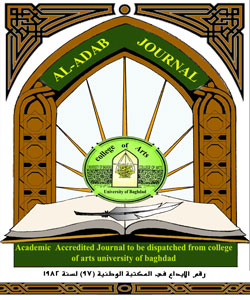'The Color imagery in the poetry of Fityan Al-Shaghuri
DOI:
https://doi.org/10.31973/aj.v1i131.694Keywords:
poetry, Fityan Al-ShaghuriAbstract
Colors, shapes and types are divine miracles. This variation in colors in the universe and nature shows the differences in the creation of all the creatures. These features were reflected in great presence as well as other sources that manifest in women, wine, gray hair, wars and their tools in the poetic imagination of the Fityan Al- Shaghury. Therefore, this poet produced the finest poetic color images and showed these colors beautifully through symbol and inspiration as a sign of meanings that paints beautiful meanings that the readers agrees with it as being is familiar in the lives of people. Other mentions of the poet manifest in the paradoxes of artistic images of beautiful colors as the point where the base of the rhetorical styles that are combined to form these images, especially metaphor, anaphylaxis, antonomasia, implicit metaphor and diagnostic and visual visions, that had a clear effect in his images, which contribute to the level of rhythmic activity in the creative color imagery.
Downloads
References
Al-Atabeki, bin Tijri Barada (1970): “The Stars of the Kings of Egypt and Cairo”, Egyptian General Establishment for Publishing, Cairo, Egypt.
Al-Basir, Kamel Hassan (1987): “Building the Artistic Image in the Arab Writing”, Publications of the Iraqi Academy of Sciences.
Al-Eimad Asfahani (1955): “The Section of the Syrian Poetry”, verified by Shukri Faisal, Arab Scientific Academy, Damascus.
Al-Hamawi, Yaqout (626H): “The Dictionary of Countries”, Presented by Mohamed Abdel-Rahman Al-Marashli (2008), Dar Al-Arabiya Press, Beirut, Lebanon, 1st Edition.
Al-Jader, Mahmoud (1990): “Performance by Genre in the poetry of Zuhair ibn Abi Salma, Journal of the Faculty of Education, University of Al-Mustansiriya, No. 2.
Al-Musli, Abn Al-Shea'ar (1990): “Qalladat Joman: Poets of this Time”, Institute of the History of Arabic and Islamic Sciences.
Al-Shaghouri, Fatayan (1955): Al-Diwan, verified by Ahmad Al-Jundi, The Hashemite Printing Press, Damascus, Syria.
Badawi, Ahmed (----): “Literary Life in the Era of the Crusades in Egypt and Syria”, House of Nahdet Misr, Cairo, 1st edition.
Diwan Al-Hutai'a (1958): verified by Naaman Amin, 1st Edition.
Hanbali, Ahmed bin Ibrahim, (876H): “Healing Hearts in Mneib Beni Ayoub Poetry”, verified by Nazim Rashid (1978), Ministry of Culture and Arts.
Ibn Khalkan, Abu Abbas (681H) (1972): “Deaths of the Figures and the News of the Sons of Time”, Ihsan Abbas, Dar Sader Press, Beirut, Lebanon.
Ibn Manzoor, Muhammad ibn Makram bin Ali, Abu al-Fadl, Jamal al-Din al-Ansari (711H) (----): “Sanan Al-Arab”, Selected Workers in Dar Al-Ma'arif Press.
Lewis, C. D (1982): “The Poetic Image, translated by Ahmed Nasif Al-Janabi, Dar Al-Rasheed Publishing, Baghdad, Iraq.
Nassif, Mustafa (1982): “The Literary Image”, Dar Al-Andalus Press, Beirut, Lebanon, 3rd Edition.
Okasha, Tharwat (1977): “Islamic, Religious and Arab Representation”, 1st Edition.
Pasha, Amr Moussa (1967): “Literature of the successive countries: Zankis, Ayyubis and Mamluks”, House of Modern Thought, 1st edition.
Saleh, Qassim Hussein (1982): “Psychology of Perception of Color and Shape”, Dar Al-Rasheed, Baghdad, Iraq.
Talo, Mohieddin (1961): “Painting and Color”, Atlas Library, Damascus, Syria.
The Holy Quran
Downloads
Published
Issue
Section
License
Copyright and Licensing:
For all articles published in Al-Adab journal, copyright is retained by the authors. Articles are licensed under an open access Creative Commons CC BY 4.0 license, meaning that anyone may download and read the paper for free. In addition, the article may be reused and quoted provided that the original published version is cited. These conditions allow for maximum use and exposure of the work.
Reproducing Published Material from other Publishers: It is absolutely essential that authors obtain permission to reproduce any published material (figures, schemes, tables or any extract of a text) which does not fall into the public domain, or for which they do not hold the copyright. Permission should be requested by the authors from the copyrightholder (usually the Publisher, please refer to the imprint of the individual publications to identify the copyrightholder).
Permission is required for: Your own works published by other Publishers and for which you did not retain copyright.
Substantial extracts from anyones' works or a series of works.
Use of Tables, Graphs, Charts, Schemes and Artworks if they are unaltered or slightly modified.
Photographs for which you do not hold copyright.
Permission is not required for: Reconstruction of your own table with data already published elsewhere. Please notice that in this case you must cite the source of the data in the form of either "Data from..." or "Adapted from...".
Reasonably short quotes are considered fair use and therefore do not require permission.
Graphs, Charts, Schemes and Artworks that are completely redrawn by the authors and significantly changed beyond recognition do not require permission.
Obtaining Permission
In order to avoid unnecessary delays in the publication process, you should start obtaining permissions as early as possible. If in any doubt about the copyright, apply for permission. Al-Adab Journal cannot publish material from other publications without permission.
The copyright holder may give you instructions on the form of acknowledgement to be followed; otherwise follow the style: "Reproduced with permission from [author], [book/journal title]; published by [publisher], [year].' at the end of the caption of the Table, Figure or Scheme.












